Recrystallization Behavior of Warm Rolling and Cold Rolling Cr-Ti-B Steel during Annealing
Abstract
1. Introduction
2. Materials and Methods
3. Results and Discussion
3.1. Microstructure
3.2. Texture
3.3. Nucleation and Recrystallization in Shear Bands
3.4. Nucleation and Recrystallization at Grain Boundaries
3.5. Nucleation and Recrystallization in Deformation Bands
4. Conclusions
- (1)
- Compared with the warm rolling process, warm rolling and cold rolling processes can obtain stronger {111} deformation textures, which are conducive to the retention of {111} texture strength during annealing.
- (2)
- Due to the high dislocation density and the nucleation mechanism of the merging of slender subgrains, recrystallization generally nucleated preferentially at the shear band. The recrystallization nucleated at the shear band was mainly Goss orientation, which was due to the existence of the Goss subgrain. There is a high grain boundary mobility between Goss texture and {111} texture, so Goss grains grow by swallowing the surrounding {111} deformed matrix at the initial stage of recrystallization.
- (3)
- The preferential recrystallization of grain boundaries was observed because of the high grain boundary energy. Although the recrystallization nucleation mechanism of the shear band and grain boundary was the subgrain combination, the recrystallization nucleation of the shear band was faster because of its slender subgrain. The texture component of recrystallization nucleation on grain boundaries was mostly {111}. Therefore, {111} texture was enhanced, and Goss texture was weakened after complete recrystallization.
- (4)
- During the annealing process, recrystallization in the deformation bands was observed at higher annealing temperatures. The recrystallization nucleation in deformation bands was much slower than that in shear bands and at grain boundaries. This is because recrystallization occurred easily at the grain boundaries due to the large distortion, and recrystallization occurred in shear bands prior to deformation bands due to the special nucleation mechanism.
Author Contributions
Funding
Data Availability Statement
Conflicts of Interest
References
- Quadir, M.Z.; Duggan, B.J. A microstructural study of the origins of c recrystallization textures in 75% warm rolled IF steel. Acta Mater. 2006, 54, 4337–4350. [Google Scholar] [CrossRef]
- Haldar, A.; Huang, X.; Leffers, T.; Hansen, N.; Ray, R.K. Grain orientation dependence of microstructures in a warm rolled IF steel. Acta Mater. 2004, 52, 5405–5418. [Google Scholar] [CrossRef]
- Jin, Y.H.; Huh, M.Y.; Chung, Y.H. Evolution of textures and microstructures in IF-steel sheets during continuous confined strip shearing and subsequent recrystallization annealing. J. Mater. Sci. 2004, 39, 5311–5314. [Google Scholar] [CrossRef]
- Gazder, A.A.; Sánchez-Araiza, M.; Jonas, J.J.; Perelorna, E.V. Evolution of recrystallization texture in a 0.78 wt.% Cr extra-low-carbon steel after warm and cold rolling. Acta Mater. 2011, 59, 4847–4865. [Google Scholar] [CrossRef]
- Nave, M.D.; Barnett, M.R.; Beladi, H. The influence of solute carbon in cold-rolled steels on shear band formation and recrystallization texture. ISIJ Int. 2004, 44, 1072. [Google Scholar] [CrossRef]
- Unnikrishnan, R.; Kumar, A.; Khatirkar, R.K.; Shekhawat, S.K.; Sapate, S.G. Structural developments in un-stabilized ultra low carbon steel during warm deformation and annealing. Mater. Chem. Phys. 2016, 183, 339–348. [Google Scholar] [CrossRef]
- Minami, H.; Funakawa, Y.; Tsuji, T.; Kobayashi, M.; Miura, H. Effects of Excess C on New Grain Formation and Static Recrystallization Behavior at Shear Bands in Cold-Rolled Ultra-Low Carbon Steel Sheets. ISIJ Int. 2021, 61, 2159–2166. [Google Scholar] [CrossRef]
- Toroghinezhad, M.R.; Humphreys, A.O.; Essadiqi, E.; Ashrafizadeh, F.; Najafizadeh, A.; Jonas, J.J. Effect of chromium, boron and manganese additions on the deformation and recrystallization textures of warm rolled low carbon steels. ISIJ Int. 2003, 43, 1842–1850. [Google Scholar] [CrossRef][Green Version]
- Haldar, A.; Ray, R.K. Microstructural and textural development in an extra low carbon steel during warm rolling. Mater. Sci. Eng. A 2005, 391, 402–407. [Google Scholar] [CrossRef]
- Guo, Y.H.; Wang, Z.D.; Xu, J.S.; Wang, G.D.; Liu, X.H. Texture evolution in a warm-rolled Ti-IF steel during cold rolling and annealing. J. Mater. Eng. Perform. 2009, 18, 378–384. [Google Scholar] [CrossRef]
- Timokhina, I.B.; Nosenkov, A.I.; Humphreys, A.O. Effect of Alloying Elements on the Microstructure and Texture of Warm Rolled Steels. ISIJ Int. 2004, 44, 717–724. [Google Scholar] [CrossRef][Green Version]
- Jonas, J.J. Effects of shear band formation on texture development in warm-rolled IF steels. J. Mater. Process. Technol. 2001, 117, 293–299. [Google Scholar] [CrossRef]
- Atake, M.; Barnett, M.; Hutchinson, B.; Ushioda, K. Warm deformation and annealing behaviour of iron–silicon–(carbon) steel sheets. Acta Mater. 2015, 96, 410–419. [Google Scholar] [CrossRef]
- Barnett, M.R. Role of In-grain Shear Bands in the Nucleation of <111>//ND Recrystallization Textures in Warm Rolled Steel. ISIJ Int. 1998, 38, 78–85. [Google Scholar] [CrossRef]
- Sánchez-Araiza, M.; Godet, S.; Jacques, P.J.; Jonas, J.J. Texture evolution during the recrystallization of a warm-rolled low-carbon steel. Acta Mater. 2006, 54, 3085–3093. [Google Scholar] [CrossRef]
- Quadir, M.Z.; Duggan, B.J. Deformation banding and recrystallization of α fibre components in heavily rolled IF steel. Acta Mater. 2004, 52, 4011–4021. [Google Scholar] [CrossRef]
- Duggan, B.J.; Tse, Y.Y.; Lam, G.; Quadir, M.Z. Deformation and recrystallization of interstitial free (IF) steel. Mater. Manuf. Processes 2011, 26, 51–57. [Google Scholar] [CrossRef]
- Tse, Y.Y.; Liu, G.L.; Duggan, B.J. Deformation banding and nucleation of recrystallization in IF steel [Interstitial Free]. Scr. Mater. 1999, 42, 25–30. [Google Scholar] [CrossRef]
- Dhinwal, S.S.; Toth, L.S.; Lapovok, R.; Hodgson, P.D. Tailoring one-pass asymmetric rolling of extra low carbon steel for shear texture and recrystallization. Materials 2019, 12, 1935. [Google Scholar] [CrossRef]
- Chen, Q.Z.; Quadir, M.Z.; Duggan, B.J. Shear band formation in IF steel during cold rolling at medium reduction levels. Philos. Mag. 2006, 86, 3633–3646. [Google Scholar] [CrossRef]
- Guo, Y.; Wang, Z.; Wei, L. Investigation on the recrystallization mechanism in warm-rolled Ti-IF steel. J. Mater. Eng. Perform. 2014, 23, 1214–1222. [Google Scholar] [CrossRef]
- Dillamore, I.L.; Morris, P.L.; Smith, C.J.E.; Hutchinson, W.B. Transition bands and recrystallization in metals, Proceedings of the Royal Society of London. A. Math. Phys. Sci. 1972, 329, 405–420. [Google Scholar]
- Mehdi, M.; He, Y.L.; Hilinski, E.J.; Kestens, L.A.; Edrisy, A. The Origins of the Goss Orientation in Non-Oriented Electrical Steel and the Evolution of the Goss Texture during Thermomechanical Processing. Steel Res. Int. 2019, 90, 1800582. [Google Scholar] [CrossRef]
- Rios, P.R.; Siciliano, F., Jr.; Sandim, H.R.Z.; Plaut, R.L.; Padilha, A.F. Nucleation and growth during recrystallization. Mat. Res. 2005, 8, 225–238. [Google Scholar] [CrossRef]
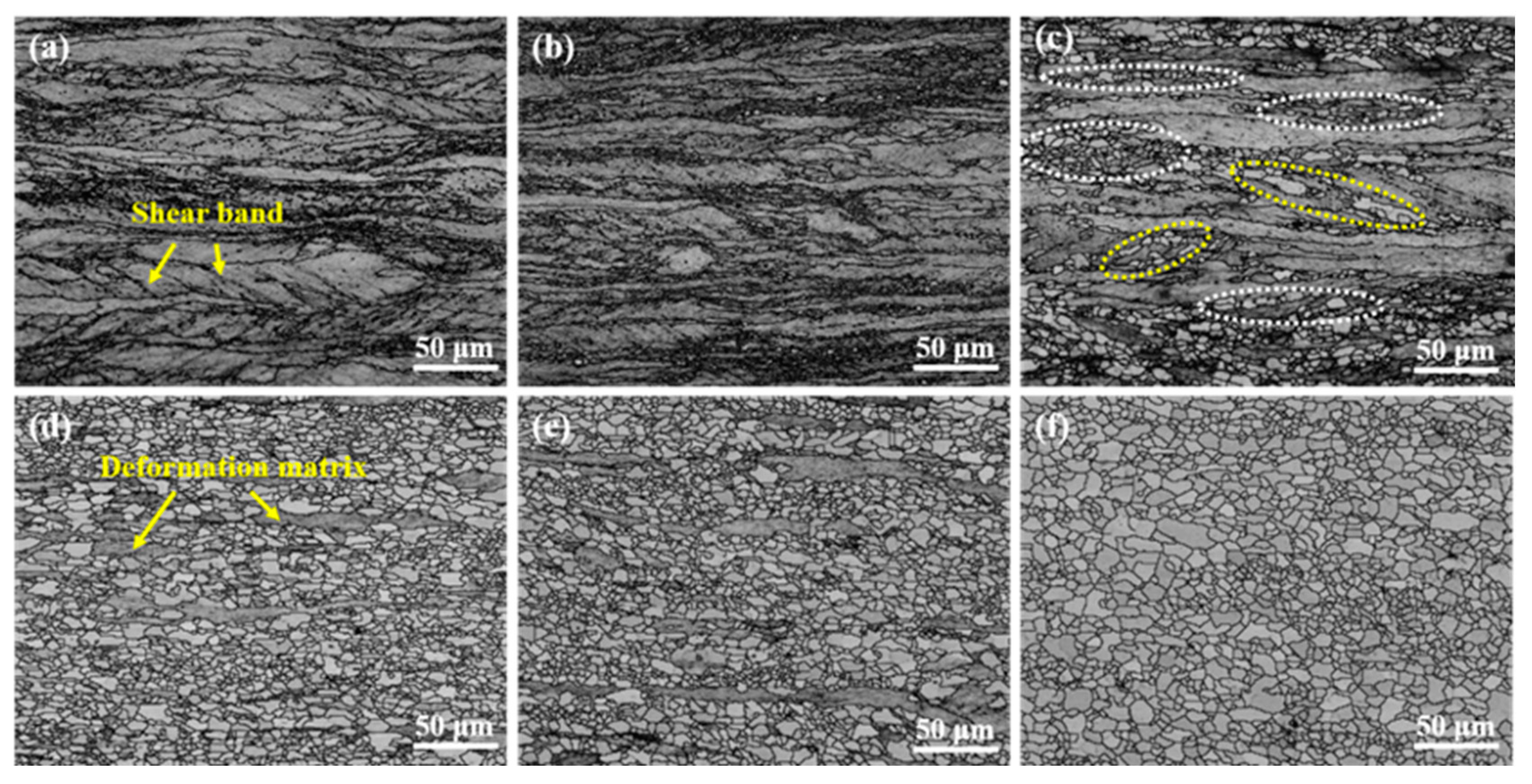


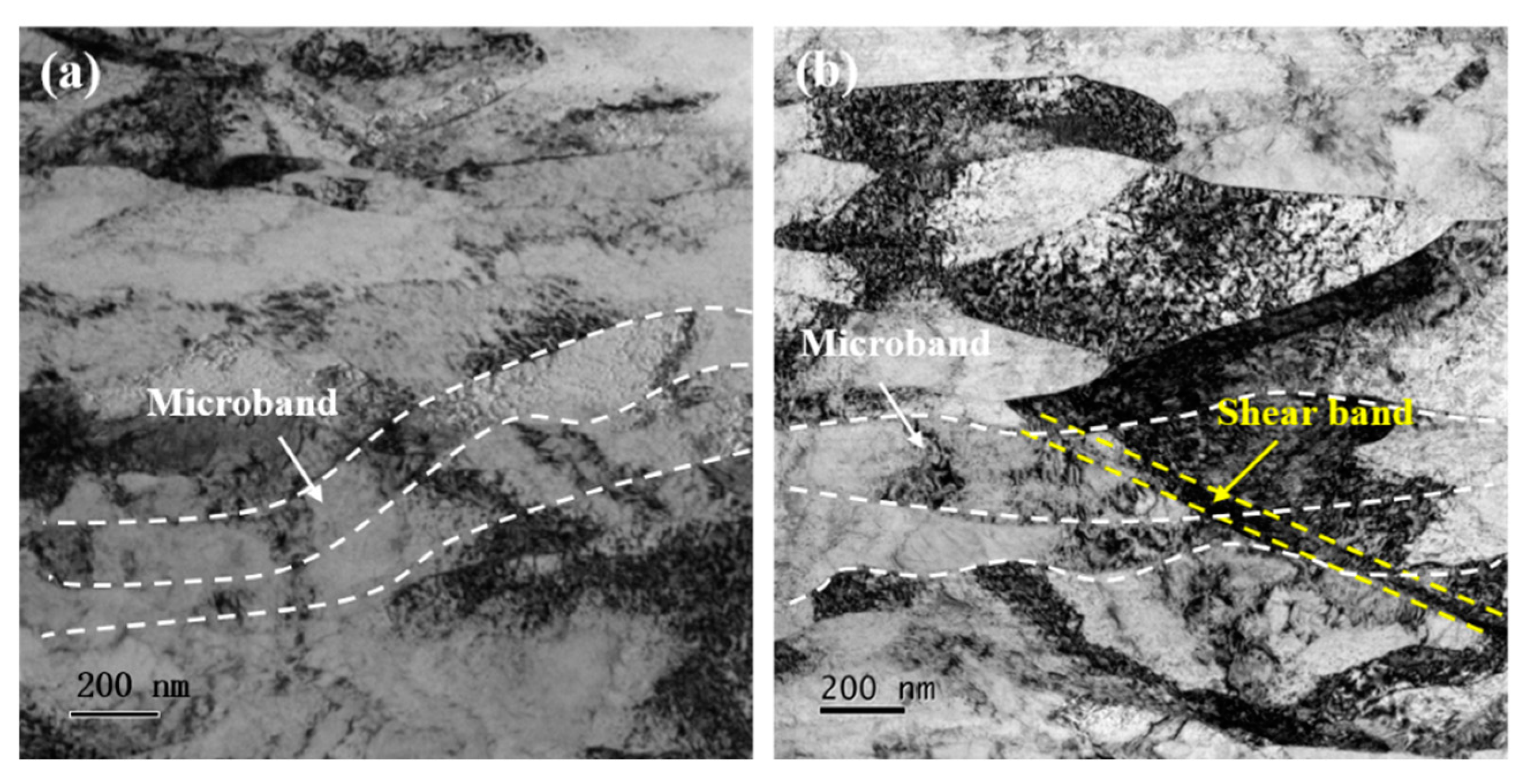
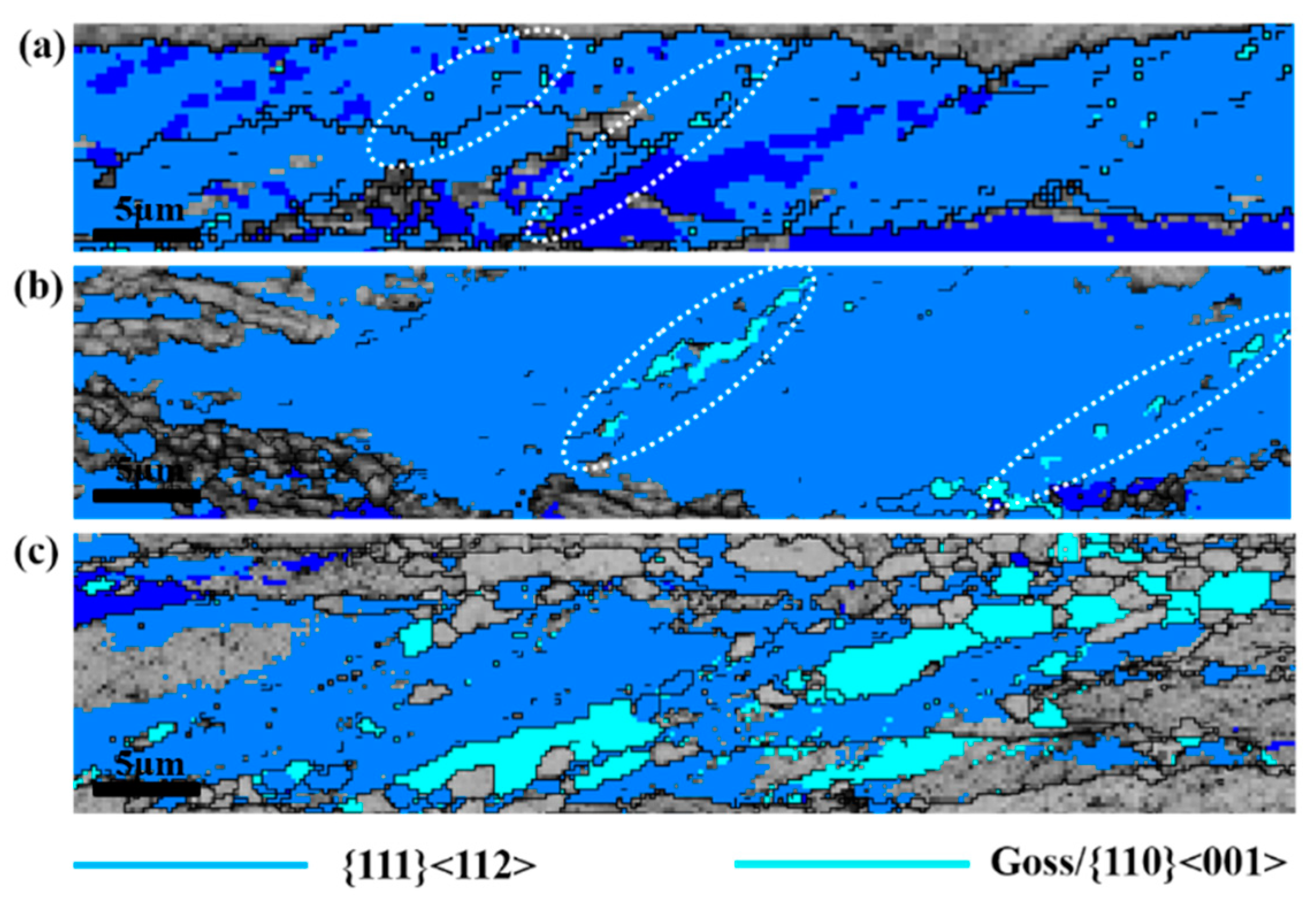
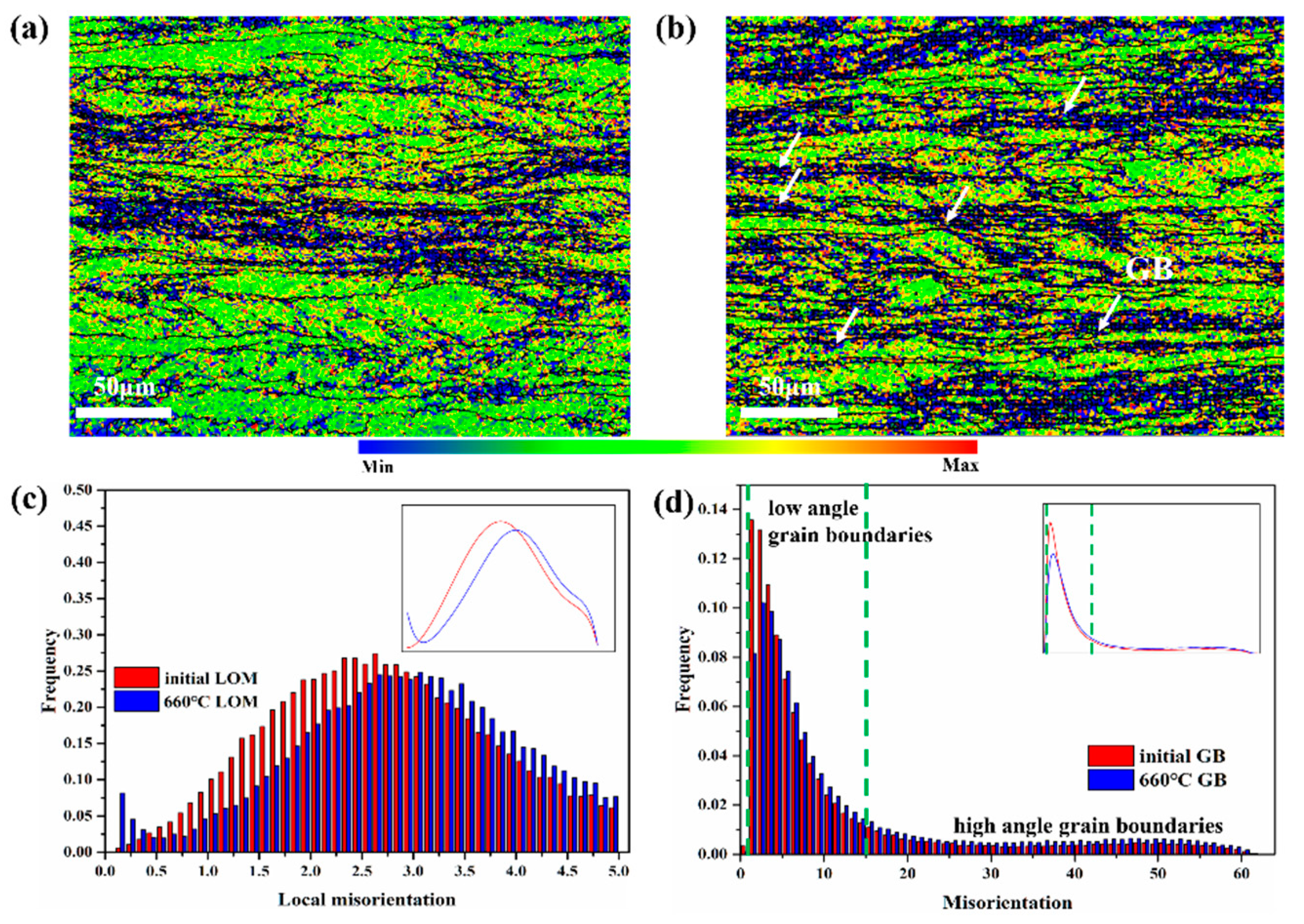
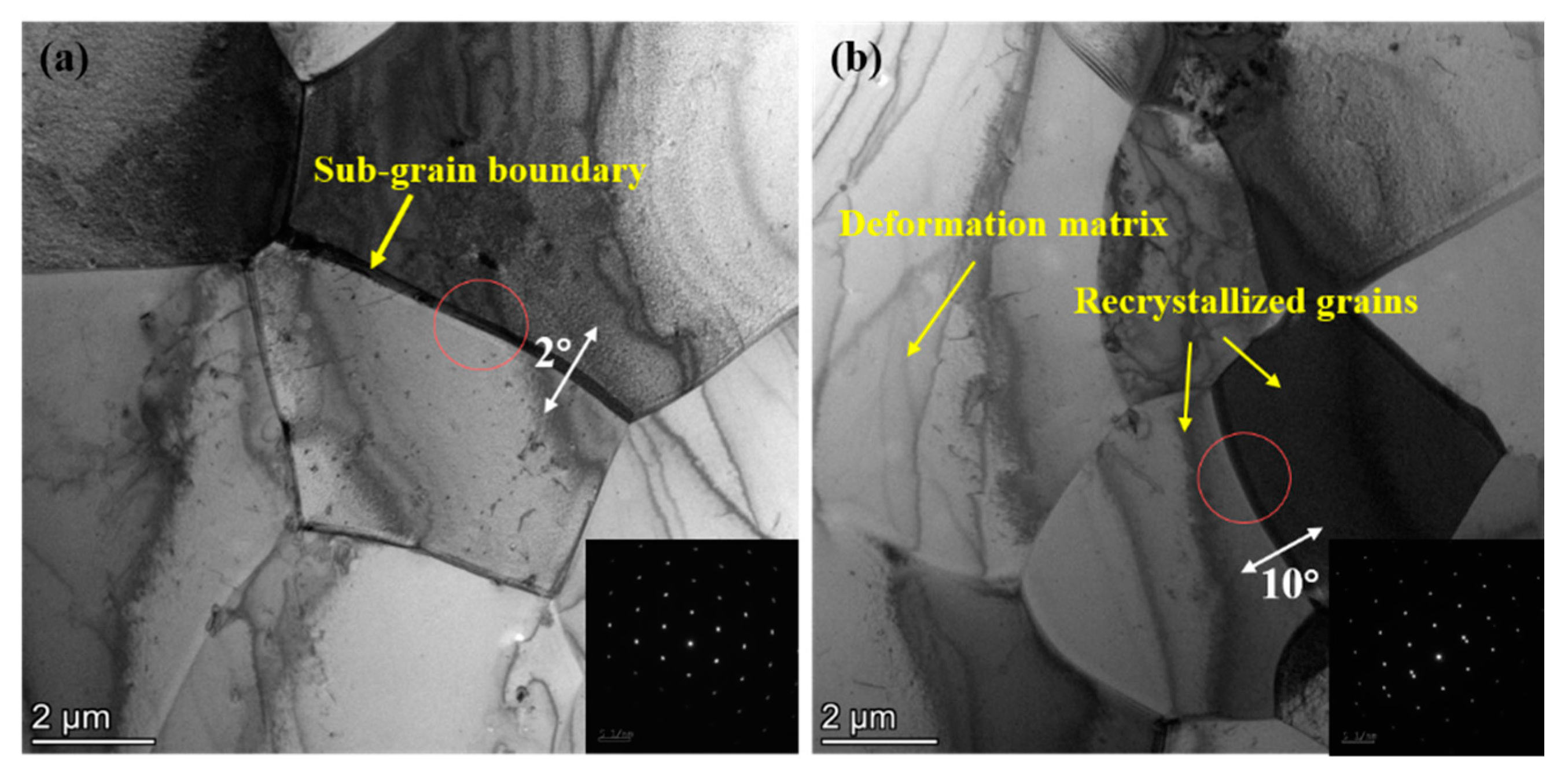
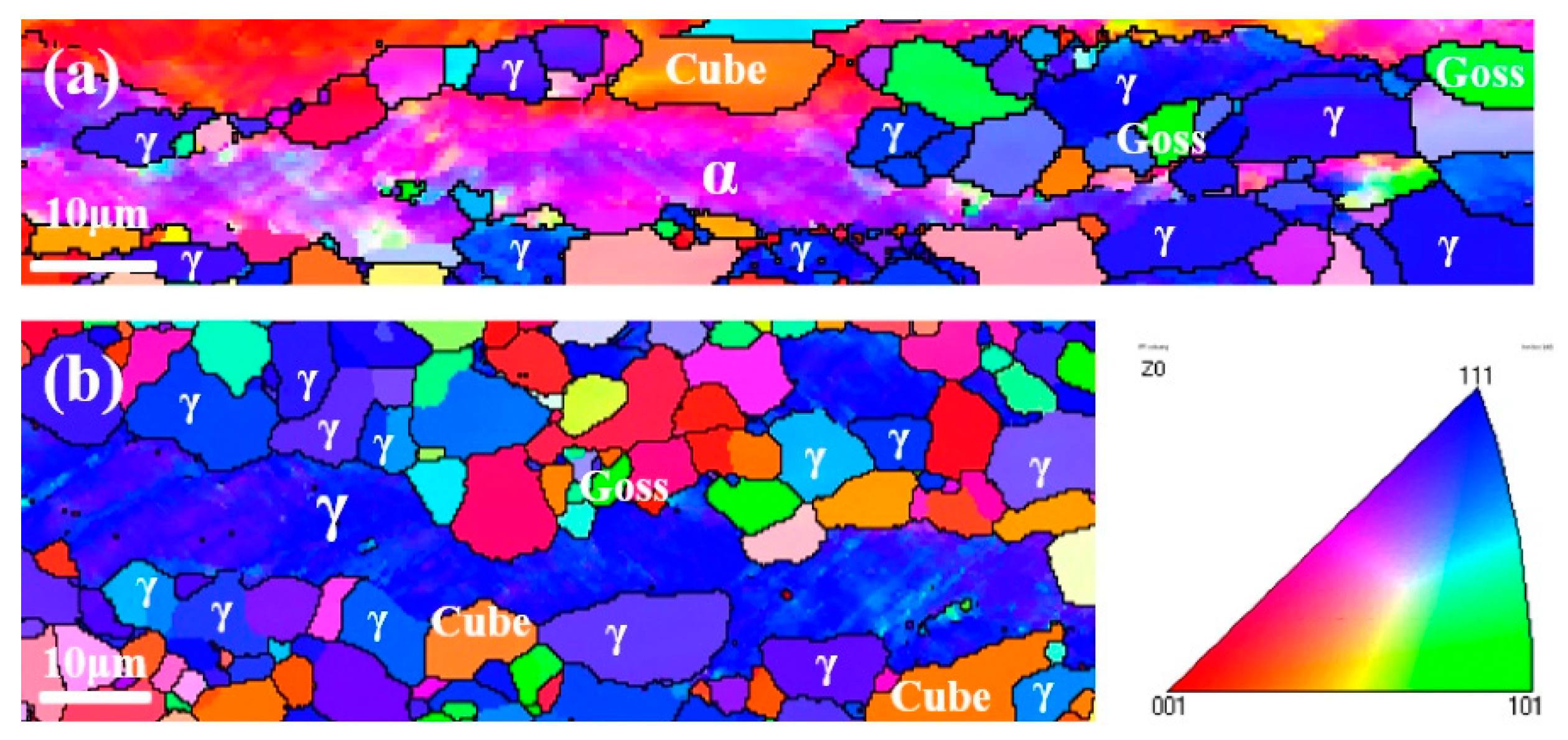
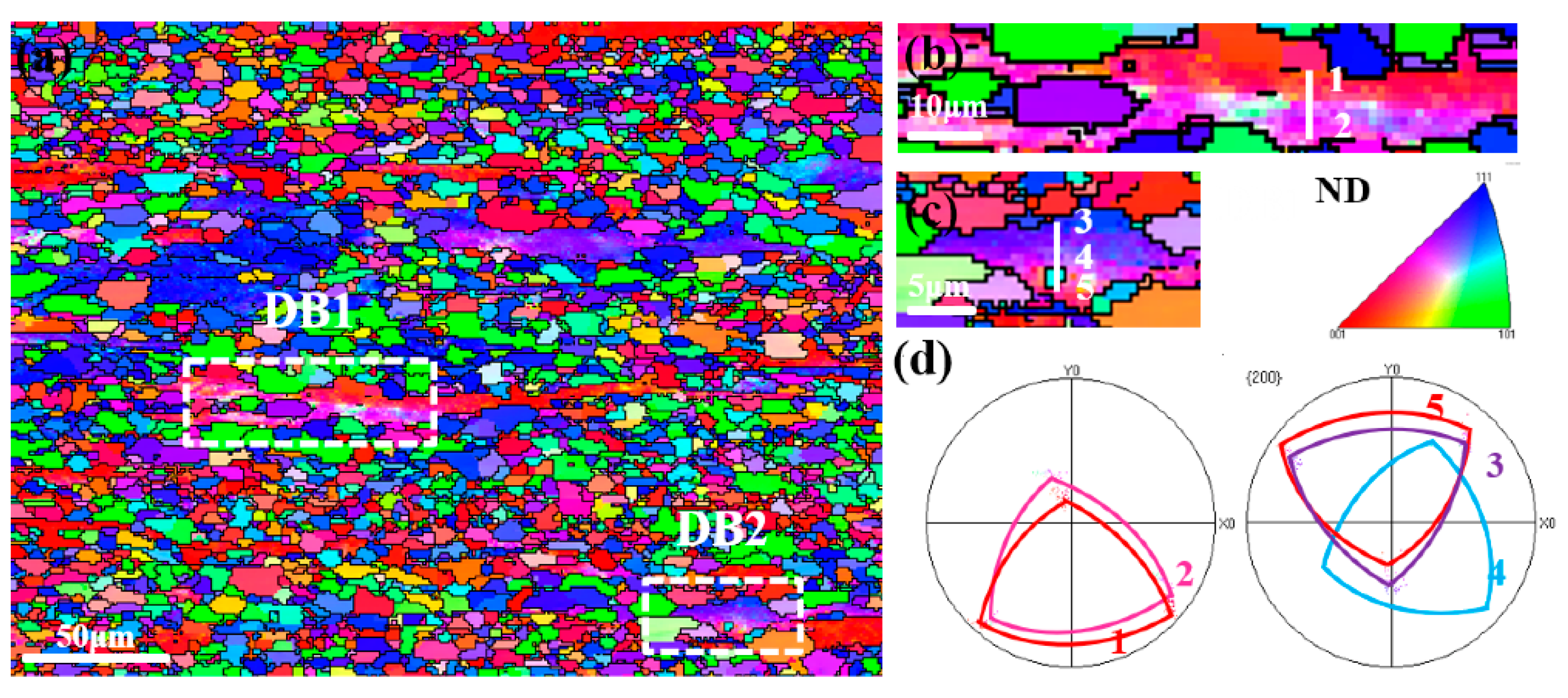
| C | Mn | Cr | Ti | Al | B | N | |
|---|---|---|---|---|---|---|---|
| Cr-Ti-B steel | 0.037 | 0.19 | 0.480 | 0.015 | 0.012 | 40 ppm | 24 ppm |
Publisher’s Note: MDPI stays neutral with regard to jurisdictional claims in published maps and institutional affiliations. |
© 2022 by the authors. Licensee MDPI, Basel, Switzerland. This article is an open access article distributed under the terms and conditions of the Creative Commons Attribution (CC BY) license (https://creativecommons.org/licenses/by/4.0/).
Share and Cite
Huang, A.; Wang, Z.; Yuan, Q.; Chen, R.; Qin, J.; Zhang, Y.; Liu, W. Recrystallization Behavior of Warm Rolling and Cold Rolling Cr-Ti-B Steel during Annealing. Metals 2022, 12, 1178. https://doi.org/10.3390/met12071178
Huang A, Wang Z, Yuan Q, Chen R, Qin J, Zhang Y, Liu W. Recrystallization Behavior of Warm Rolling and Cold Rolling Cr-Ti-B Steel during Annealing. Metals. 2022; 12(7):1178. https://doi.org/10.3390/met12071178
Chicago/Turabian StyleHuang, Ankang, Zhigang Wang, Qiangqiang Yuan, Rongchun Chen, Jing Qin, Yinghui Zhang, and Weizhen Liu. 2022. "Recrystallization Behavior of Warm Rolling and Cold Rolling Cr-Ti-B Steel during Annealing" Metals 12, no. 7: 1178. https://doi.org/10.3390/met12071178
APA StyleHuang, A., Wang, Z., Yuan, Q., Chen, R., Qin, J., Zhang, Y., & Liu, W. (2022). Recrystallization Behavior of Warm Rolling and Cold Rolling Cr-Ti-B Steel during Annealing. Metals, 12(7), 1178. https://doi.org/10.3390/met12071178







